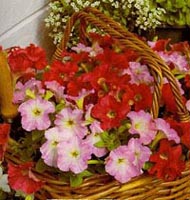Resource Library
Plant of the Week: Petunia
The University of Arkansas System Division of Agriculture does not promote, support or recommend plants featured in "Plant of the Week." Please consult your local Extension office for plants suitable for your region.
Plant of the Week
Petunia
Latin: Petunia x hybrida

We gardeners are a fickle lot -- first we can’t get enough of a plant and then we
tire of it as we move to other interesting floral ornaments. The lowly petunia has
been down this road several times in the years since it was brought to our gardens
-- at first loved and highly desired, then spurned, only to be resurrected from the
compost heap of garden treasures as a new generation of gardeners discover its merits.
If you haven’t noticed, petunias are back.
The petunia, a relative of tobacco, originated in South America and takes its name
from the aboriginal name for the plant which means something like "a kind of tobacco
that doesn’t make a good smoke."
While Argentina was in Spanish possession, exploration by outsiders was forbidden
for almost 300 years, in an attempt to preserve the silver and gold resources for
Spain.
When Spain fell during the Napoleonic Wars, Argentina was able to gain self rule
in 1816. By 1825, the new nation adopted one of the most liberal policies on emigration
in the New World, to encourage farmers, merchants and trained professionals to come
settle the land.
One who answered the call was James Tweedie, the head gardener at the botanic garden
at Edinburgh, Scotland. During the next 25 years Tweedie traveled the land and introduced
many Argentine plants to Europe, including the three species of petunia used to make
the hybrid petunia.
Even though the wild petunias first went to Europe, they eventually made their way
to the United States where the hybrid petunia we know today was developed. Much of
the early hybridization work on petunias was done by a Mrs. Thomas Gould of California
in the late 1800's.
She developed the first really large flowered forms, the California Giant strains,
that were a sensation in their day and were still in cultivation as late as 1980.
The California Giants were
initially created by hybridizing the wild species and then going through a series
of selections until the open pollinated breeding line was "fixed" and would come true
from seeds.
Today, all petunia seeds that are sold are F1 hybrids that are created by hand crossing
two parents, one of which provides vigor and the other flower color. Because of the
hand labor involved, much of the work is done in Central America and India where labor
costs are low.
The vigor parent is reminiscent of the wild species with its light lavender flowers.
If petunias are allowed to reseed this is the only form likely to survive. The color
parent is such a weak grower that it can’t compete in the wild garden.
The new interest in petunias came about because of some vigorous petunias, the Surfinas,
that were introduced in the early 1990's. The Surfinas, just like double flowered
forms of a century earlier, are propagated by cuttings, not seeds. The mid-decade
introduction of the really vigorous seed-grown Wave petunias further built on this
interest.
In the garden, petunias are loved because they are available in almost every shade
imaginable and they flower all summer long. They should be planted in areas with at
least six hours of sunlight, a reasonably fertile soil and good drainage.
While petunias benefit from deadheading, few have the time or patience to do this
task every few days as needed. A good compromise is to go through the planting in
mid-summer and selectively cut branches back about half way, thus encouraging new
growth and continued flowering through the summer. A good fertility program will help
insure good growth all summer long and keep plants blooming.
By: Gerald Klingaman, retired
Extension Horticulturist - Ornamentals
Extension News - March 5, 1999
The University of Arkansas System Division of Agriculture does not maintain lists of retail outlets where these plants can be purchased. Please check your local nursery or other retail outlets to ask about the availability of these plants for your growing area.